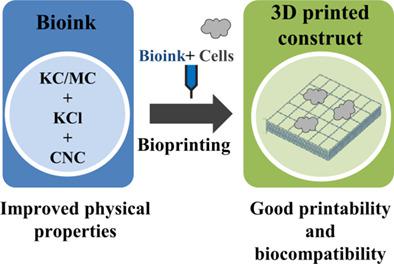当前位置:
X-MOL 学术
›
Polym. Int.
›
论文详情
Our official English website, www.x-mol.net, welcomes your feedback! (Note: you will need to create a separate account there.)
Characterization of κ-carrageenan/methylcellulose/cellulose nanocrystal hydrogels for 3D bioprinting
Polymer International ( IF 3.2 ) Pub Date : 2021-09-17 , DOI: 10.1002/pi.6298 Wannisa Boonlai 1 , Vimon Tantishaiyakul 1, 2 , Namon Hirun 3
Polymer International ( IF 3.2 ) Pub Date : 2021-09-17 , DOI: 10.1002/pi.6298 Wannisa Boonlai 1 , Vimon Tantishaiyakul 1, 2 , Namon Hirun 3
Affiliation

|
Bioinks composed of various concentrations of κ-carrageenan (KC) and methylcellulose (MC) were investigated for extrusion-based bioprinting. The physical property of the 0.3% w/w KC/7% w/w MC (0.3KC/7MC) hydrogel was successfully enhanced using ionic crosslinking with 0.1% w/w KCl (0.1KCl). Furthermore, various concentrations of cellulose nanocrystal (CNC) were incorporated into the 0.3KC/7MC/0.1KCl hydrogel to increase its mechanical performance. Shear thinning and thixotropic properties are important for extrusion-based bioprinting. The presence of 2% w/w CNC (2CNC) and 4% w/w CNC (4CNC) in the hydrogels (0.3KC/7MC/0.1KCl/2CNC and 0.3KC/7MC/0.1KCl/4CNC) led to good thixotropic behavior. In addition, increasing CNC concentrations showed greater shear thinning behavior. Furthermore, 0.3KC/7MC/0.1KCl/4CNC exhibited better printability than 0.3KC/7MC/0.1KCl/2CNC. The compressive mechanical property was significantly higher in the presence of CNC with compressive stress at 30% strain for 0.3KC/7MC/0.1KCl, 0.3KC/7MC/0.1KCl/2CNC and 0.3KC/7MC/0.1KCl/4CNC of 6.43 ± 0.41, 20.03 ± 0.02 and 23.28 ± 0.01 kPa, respectively. A good cell viability (>90%) was obtained for the 3D bioprinted 0.3KC/7MC/0.1KCl/2CNC and 0.3KC/7MC/0.1KCl/4CNC constructs. The novel 0.3KC/7MC/0.1KCl/4CNC hydrogel showed good attributes for a promising 3D bioprinting material. © 2021 Society of Industrial Chemistry.
中文翻译:

用于 3D 生物打印的 κ-角叉菜胶/甲基纤维素/纤维素纳米晶体水凝胶的表征
研究了由不同浓度的 κ-角叉菜胶 (KC) 和甲基纤维素 (MC) 组成的生物墨水用于基于挤出的生物打印。使用 0.1% w/w KCl (0.1KCl) 的离子交联成功地增强了 0.3% w/w KC/7% w/w MC (0.3KC/7MC) 水凝胶的物理性能。此外,将各种浓度的纤维素纳米晶体 (CNC) 掺入到 0.3KC/7MC/0.1KCl 水凝胶中以提高其机械性能。剪切变稀和触变性对于基于挤出的生物打印很重要。在水凝胶(0.3KC/7MC/0.1KCl/2CNC 和 0.3KC/7MC/0.1KCl/4CNC)中存在 2% w/w CNC (2CNC) 和 4% w/w CNC (4CNC) 导致良好的触变性行为。此外,增加 CNC 浓度显示出更大的剪切变稀行为。此外,0.3KC/7MC/0.1KCl/4CNC 表现出比 0 更好的印刷适性。3KC/7MC/0.1KCl/2CNC。0.3KC/7MC/0.1KCl、0.3KC/7MC/0.1KCl/2CNC 和 0.3KC/7MC/0.1KCl/4CNC 在 30% 应变下的压缩应力下,压缩力学性能显着提高 6.43 ±分别为 0.41、20.03 ± 0.02 和 23.28 ± 0.01 kPa。3D 生物打印的 0.3KC/7MC/0.1KCl/2CNC 和 0.3KC/7MC/0.1KCl/4CNC 构建体获得了良好的细胞活力 (>90%)。新型 0.3KC/7MC/0.1KCl/4CNC 水凝胶显示出良好的特性,是一种有前途的 3D 生物打印材料。© 2021 工业化学学会。3D 生物打印的 0.3KC/7MC/0.1KCl/2CNC 和 0.3KC/7MC/0.1KCl/4CNC 结构获得了 90%)。新型 0.3KC/7MC/0.1KCl/4CNC 水凝胶显示出良好的特性,是一种有前途的 3D 生物打印材料。© 2021 工业化学学会。3D 生物打印的 0.3KC/7MC/0.1KCl/2CNC 和 0.3KC/7MC/0.1KCl/4CNC 结构获得了 90%)。新型 0.3KC/7MC/0.1KCl/4CNC 水凝胶显示出良好的特性,是一种有前途的 3D 生物打印材料。© 2021 工业化学学会。
更新日期:2021-09-17
中文翻译:

用于 3D 生物打印的 κ-角叉菜胶/甲基纤维素/纤维素纳米晶体水凝胶的表征
研究了由不同浓度的 κ-角叉菜胶 (KC) 和甲基纤维素 (MC) 组成的生物墨水用于基于挤出的生物打印。使用 0.1% w/w KCl (0.1KCl) 的离子交联成功地增强了 0.3% w/w KC/7% w/w MC (0.3KC/7MC) 水凝胶的物理性能。此外,将各种浓度的纤维素纳米晶体 (CNC) 掺入到 0.3KC/7MC/0.1KCl 水凝胶中以提高其机械性能。剪切变稀和触变性对于基于挤出的生物打印很重要。在水凝胶(0.3KC/7MC/0.1KCl/2CNC 和 0.3KC/7MC/0.1KCl/4CNC)中存在 2% w/w CNC (2CNC) 和 4% w/w CNC (4CNC) 导致良好的触变性行为。此外,增加 CNC 浓度显示出更大的剪切变稀行为。此外,0.3KC/7MC/0.1KCl/4CNC 表现出比 0 更好的印刷适性。3KC/7MC/0.1KCl/2CNC。0.3KC/7MC/0.1KCl、0.3KC/7MC/0.1KCl/2CNC 和 0.3KC/7MC/0.1KCl/4CNC 在 30% 应变下的压缩应力下,压缩力学性能显着提高 6.43 ±分别为 0.41、20.03 ± 0.02 和 23.28 ± 0.01 kPa。3D 生物打印的 0.3KC/7MC/0.1KCl/2CNC 和 0.3KC/7MC/0.1KCl/4CNC 构建体获得了良好的细胞活力 (>90%)。新型 0.3KC/7MC/0.1KCl/4CNC 水凝胶显示出良好的特性,是一种有前途的 3D 生物打印材料。© 2021 工业化学学会。3D 生物打印的 0.3KC/7MC/0.1KCl/2CNC 和 0.3KC/7MC/0.1KCl/4CNC 结构获得了 90%)。新型 0.3KC/7MC/0.1KCl/4CNC 水凝胶显示出良好的特性,是一种有前途的 3D 生物打印材料。© 2021 工业化学学会。3D 生物打印的 0.3KC/7MC/0.1KCl/2CNC 和 0.3KC/7MC/0.1KCl/4CNC 结构获得了 90%)。新型 0.3KC/7MC/0.1KCl/4CNC 水凝胶显示出良好的特性,是一种有前途的 3D 生物打印材料。© 2021 工业化学学会。



























 京公网安备 11010802027423号
京公网安备 11010802027423号